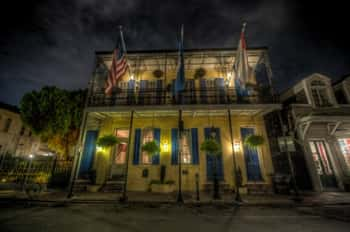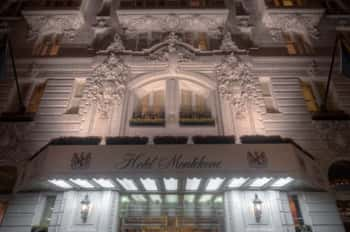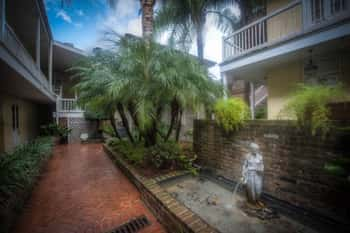Along Toulouse Street, Hotel Maison de Ville is a quiet, beautiful French Quarter property. Stucco painted a dusky red and one single dormer peeping out from the hipped roof, this boutique hotel could easily pass as another luxurious residence.
According to some of the hotel’s employees and guests, that assumption isn’t so far off from the truth. During a tour of the property, the hotel was described as ‘intimate,’ like staying at a rich aunt’s house.
That description is spot on: with a 2,000 square foot interior courtyard that’s got a view of the Court of Two Sisters' patio, and a room known as the Tennessee Williams suite because America’s most famous playwright actually stayed there, Hotel Maison de Ville is more than just a pretty facade.
Named Fodor’s 100 Hotel Award Winner in 2013, this hotel, whose name literally translates to ‘townhouse’ in French, has been home to some of New Orleans’ most interesting historical figures over the centuries. And if some of the hotel’s so-called “residents” seem to be more of the permanent, paranormal variety . . . Well, it makes sense that Hotel Maison de Ville is routinely voted as one of New Orleans’ most haunted places to stay while traveling in the Big Easy.
Although the old servants quarters at the rear of 727-733 Toulouse Street were erected sometime in the 1730s, during the height of the French Colonization period, much of the main dwelling was later rebuilt ca. 1793.
Its owner was a wealthy French merchant by the name of Jean Baptiste DeLille Sarpy. Little information exists about DeLille Sarpy, but we do that he remained at the property until 1800, and that his youngest child would prove to be one of the most remarkable women in New Orleans history.
Though the French-born Jean Baptiste DeLille Sarpy had married twice, he also enjoyed a conjugal relationship with a woman named Marie-Josephe “Pouponne" Diaz. Whether he had hoped to or not, marriage to Marie-Josephe was not a viable legal option.
You see, Marie-Josephe "Pouponne" Diaz was a free quadroon (this being a racially-loaded historical term meaning one-fourth African). In early New Orleans, there was a shortage of "socially acceptable" white women to marry. White Creole men turned to having relations with black women, both free and enslaved. Law, however, prohibited any sort of marriage, and so the generations continued so forth . . . A Creole man chose a woman of his liking, sometimes even two or three at a time, and he provided her with money and a house all in exchange for his “protection." The daughters of these relationships were groomed to be placed back into this system, called plaçage, and the tradition continued for another generation.
Was 727 Toulouse Street the home for Jean Baptiste DeLille Sarpy and his mistress, Marie-Josephe? The DeLille Sarpy family moved out of 727 Toulouse in 1800, and in 1812, Marie-Josephe gave birth to Jean Baptiste’s youngest daughter, Henriette. As a free woman of color, Henriette was allowed to pray with the Ursulines and even sing in the mixed choir, but she was not allowed to postulant with the Ursuline nuns. This racial stratification was the pushing factor for Henriette to found the first African-American convent.
The 1830 census reveals that Henriette’s siblings, and even her mother, listed themselves as “white.” Henriette did not do the same. In the same census, she deemed herself a “free woman of color,” acknowledging her African lineage and simultaneously damning herself in the eyes of the law. She first operated her convent, the Sisters of the Holy Family, in secret, but later did so publicly with the support of the Church. Today, she is in the midst of the canonization process to be beatified.
For Hotel Maison de Ville, this is perhaps the property where Henriette’s father Jean Baptiste first lived with Marie-Josephe, and one must wonder about their relationship. Who were Jean Baptiste and Marie-Josephe on a deeper, more personal level? And how might they have reacted to the knowledge that their youngest daughter would grow to be remembered centuries after her death?
It was 7 April 1836 when Delphine Emesie Macarty moved to 733 Toulouse Street. She was a young woman at the time, perhaps only around twenty-one years old.
But despite her youth, Emesie Macarty had experienced more scandal than most do in their entire lifespans. Emesie was the half-sister of New Orleans’ most infamous woman, "Mad" Madame Marie Delphine Macarty LaLaurie, who was recently made even more notorious after being featured as a character on American Horror Story’s third season, Coven.
Emesie was born in 1815 to a free quadroon, Sophie Mousante, and Marie Delphine’s father, Don Luis Chevalier Macarty. Luis Chevalier Macarty’s wife had not yet died in 1807 when he struck up a relationship with Sophie. But the men of the French-Irish Macarty clan were not known for their monogamy. Emesie’s own uncle had a 54-year business and romantic relationship with his quadroon mistress; he never married anyone else, and he lived with her in their cottage until the time of his death. (Still, he had two other mistresses on the side, who also bore him children.)
This was, for better or for worse, the world that the Macartys lived in during the early nineteenth century.
At the time of Emesie’s birth, no father was listed on her baptismal record, but later the “unknown” was scratched out and Luis Chevalier Macarty’s name written above. At the time of his death in 1824, his will acknowledged that Emesie had been “born of [his] cohabitation in lieu of marriage with the free woman of color Sophie Mousante.” Emesie’s father then gifted her with $5,000 and two slaves, Rosa and Theophile, as a token of his affection.
Horrific tales swirl around her half-sister, Marie Delphine LaLaurie. Writers have guessed that because all the men in Marie Delphine's family openly had relationships with free women of color, her brutality toward her slaves was an act of retaliation. This is probably not the case, as historian Caroline Morrow Long has pointed out.
Not only did Marie Delphine and her brother, Louis Barthelemy, stand in as godparents for Emesie, but in 1834—the same year as the devastating fire—they gave her a slave “as a demonstration of their affection.”
During that same year, Emesie was living at the corner of Rampart and Ursulines Avenue, just blocks from her half-sister, with her white protector, Benjamin Hart. We can only imagine how Emesie must have felt after it came out that her half-sister had been brutally torturing her slaves in the attic of her home. Marie Delphine fled the city for Paris; her children followed suit shortly after at their mother’s bidding. Only one son ever returned to New Orleans.
The once powerful Macarty clan slowly began to crumble, and in 1836 Emesie and Benjamin Hart moved to 733 Toulouse. Was it done to put more distance between them and the other Macarty family members, who all lived close to the LaLaurie Mansion? Although we will never know, we do know that Emesie Macarty and Hart remained at the now-Maison de Ville site for just a year before they moved on.
By 1846, Emesie and Hart had left the city entirely, just like Marie Delphine. They and their children moved to Philadelphia, where they were listed as “white” in every census between 1850-1880. Even in the notarial record for the 733 Toulouse Street property, Emesie is not documented as a “free woman of color,” proving that she must have appeared so fair that she could pass as Caucasian.
In Philadelphia, Emesie went by the name Delphine Hart, and after Benjamin’s death, she became a music teacher.
We can only imagine what sort of conversations might have been held by Emesie and her family during that one year period in the mid-1830s, just two years after the devastating fire that outed her half-sister as a cold killer to all of New Orleans society. It seems that in this case, the Hotel Maison de Ville’s walls are holding more secrets that we can even begin to imagine.
In the early 1800s, a man by the name of Antoine Amede Peychaud allegedly owned the lot of the Hotel Maison de Ville. Who was Peychaud, and why in the world do New Orleanians speak of him so reverently?
By all accounts, Peychaud was the originator—the founding father, if you will—of today’s modern cocktail.
(Perked up at that, did you?)
Though Peychaud actually worked as a pharmacist and owned an apothecary just around the corner from 727 Toulouse, he was the first to create “bitters” as we know of them today. Medicinally, the alcoholic bitters functioned as a tonic that cured all sorts of sicknesses. After hours at his apothecary, he apparently used to welcome friends and seat them on the bar stools and whip them up something flavorful.
A mix of brandy and the herbal bitters into an eggcup, or coquetier, served up a delicious mixed drink that started gaining public notoriety and attention. By the mid-nineteenth century, “Peychaud’s Bitters” had been copyrighted and given a new name, the Sazerac, which is considered to be New Orleans’ oldest cocktail. (Looking for the best Sazerac in the city? Check out Hermes, Antoine's Restaurant's bar. You won't find better.)
It wasn’t until 1944 that the property of 727 Toulouse was converted into a hotel, the precursor to the Hotel Maison de Ville. As the story goes, Madeline Erlich was visiting New Orleans during World War II when she was introduced to travel agent, Mrs. Mary McDougall. Mrs. McDougall extended an invitation for Madeline to visit her home, and Madeline, well, she took one look at the patio in the back of the house and she fell immediately in love.
Why, she wondered in dismay, does the French Quarter not have a hotel like a courtyard like this?
Madeline Erlich took it upon herself to open a hotel just like the one she had dreamed about. Turns out that in looking at various properties, none struck her as more beautiful, more lovely, than the McDougall home. 727 Toulouse Street.
Madeline somehow managed to convince Mrs. McDougall and her family that they really ought to move to a new location, and she quickly moved in and started converting the property into a guest house.
Over the years, the guesthouse merged and was sold as the Hotel Maison de Ville. This luxurious property has welcomed all sorts of celebrity guests, including Michael Jackson, Elizabeth Taylor, Paul McCartney and Tennessee Williams. (Tennessee Williams fans: book your stay in Room 9. This is where he wrote A Streetcar Named Desire!)
But who, exactly is haunting this historic hotel? If only the answer to that was as easy as booking your reservation at the Hotel Maison de Ville.
It’s not uncommon for the buildings of the French Quarter to have a spirit or two still wandering its corridors, but the Maison de Ville certainly has more than its fair share of paranormal activity.
At this haunted hotel, it’s not a matter of if something otherworldly will grace you with its presence, but only a matter of when . . .
Down in Louisiana, country music is sort of a staple. Sure, we might not be Texas with our big cowboy hats or longhorn cattle, but we New Orleanians like our Jason Aldean and Rascal Flatts just fine.
If you book your reservations for Cottage Four at the Hotel Maison de Ville, however . . . I hope you’ve got a real penchant for country music.
Guests and employees alike have reported seeing the spirit of a soldier dressed in a 1940s uniform, his hand always resting on a radio knob. Country music has been heard lilting in the air—but don’t bother changing the station if the music isn’t to your taste. Apparently the ghostly soldier haunting Cottage Four doesn’t favor other types of music and soon enough the twang of a honky-tonk song can be heard again.
Seances have been held in this cottage by those seeking the ghostly spectral. His spirit has appeared, solid as you or me, but then the soldier twists away, silent footsteps falling on the floor before disappearing right into the wall.
Who exactly is this ghostly soldier? One investigator reported catching the spirit’s voice saying, “I need to leave.” Photos have caught the ghost on camera, his medals of honor glinting in the light.
And according to employees of the Hotel Maison de Ville, the shutters won’t close in Cottage Four. It seems that for all of this ghost’s caterwauling about leaving the haunted hotel, he seems content to stay.
If you hear the strains of a banjo or the husky voice of a country star belting their heart out, keep watch: You’ve probably got a visitor from The Other Side.
In January of 2013, the Louisiana Paranormal Society approached the Hotel Maison de Ville about holding a paranormal investigation within its historic walls. The hotel said yes, and the paranormal team set up their ghost-hunting equipment.
That night, on January 15th, the Louisiana Paranormal Society perhaps got more than they had initially bargained for. Within moments of beginning, they heard the sounds of footsteps and whispering; they saw a shadow peep over the edge of a bed in the main building, as if the spirit too was interested to learn about the paranormal activity occurring in the hotel.
They reported books being moved about in the Frenchman’s Cottage, and also caught the EVP of a man’s voice claiming, “I’m a suicide,” within the same space. After much research and looking through all sorts of historical databases, nothing has popped up validating this chilling statement caught during the investigation.
Who was this man who allegedly took his life in the Frenchman’s Cottage? With no concrete evidence, it’s difficult to tell. But the Louisiana Paranormal Society heard the words loud and clear and sometimes in the ghostly world, an event does not have to happen on a particular site for hauntings to occur there.
This potential suicide could have happened across the street, even, but if the spirit has chosen the Hotel Maison de Ville as his final resting place . . . Well, it appears that he is here to stay.
One can only hope that this troubled spirit has found peace after death that he apparently never found in life.
Creaky stairs under the weight of feet are to be expected at any old building, but at the Maison de Ville, the quiet of the night is broken by otherworldly sounds. Guests have alerted employees to hearing knocking sounds on the doors, on the walls; and the whisper of disembodied voices have caused shivers to race down guests’ spines, the hair to raise up on their arms.
Sheets have been pulled off guests during the midst of the night, and feet have been tugged by a playful spirit intent on riling things up. Others staying at the hotel have seen unexplainable wet footprints pressed into the carpet or dotting the tiled floor.
It seems safe to say that the Hotel Maison de Ville at 727 Toulouse Street is humming with paranormal activity. From a country music lovin’ ghost to a man who reportedly committed suicide to the playful spirit tickling guests’ feet, this historic hotel provides more for its guests than just a luxurious vacation stay.
727 Toulouse has been home to famous New Orleanians and their family during the course of history. What imprint, if any, did these people leave upon this plot of land? And are they responsible for any of the ghostly happenings occurring at this haunted hotel? (Here’s to hoping that Madame Delphine LaLaurie’s ghost is no where near the vicinity of this location).
Rated as one of New Orleans’ premier hotels, the Maison de Ville mixes traditional Southern hospitality and French Quarter luxury into a seamlessly blended cocktail fit for anyone’s enjoyment.
Antoine Peychaud would be proud of this fine establishment, wouldn’t you say?

The site of a deadly fire

New Orleans' most haunted Hotel

Who haunts this famous Hotel?